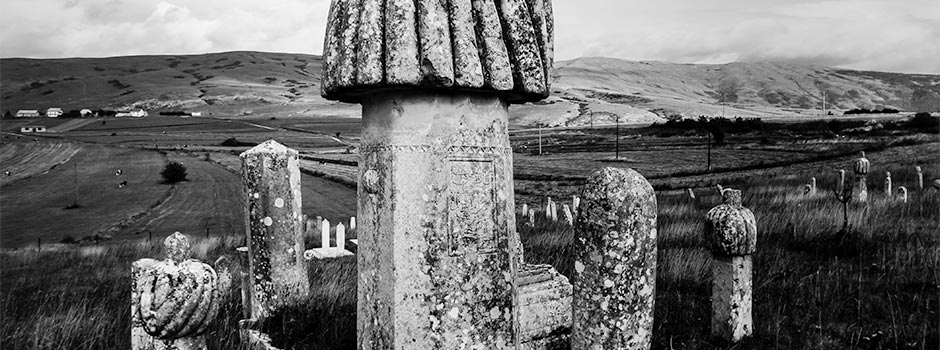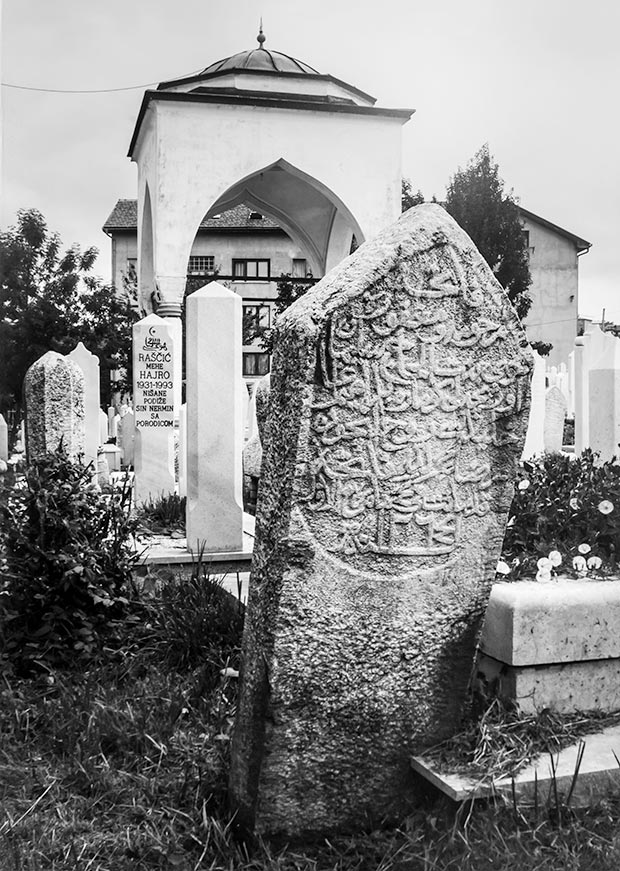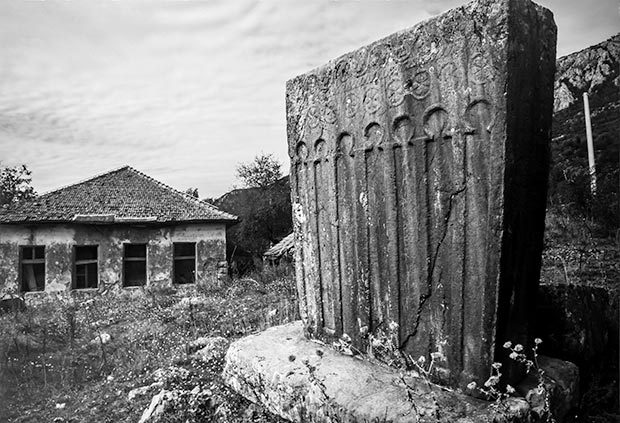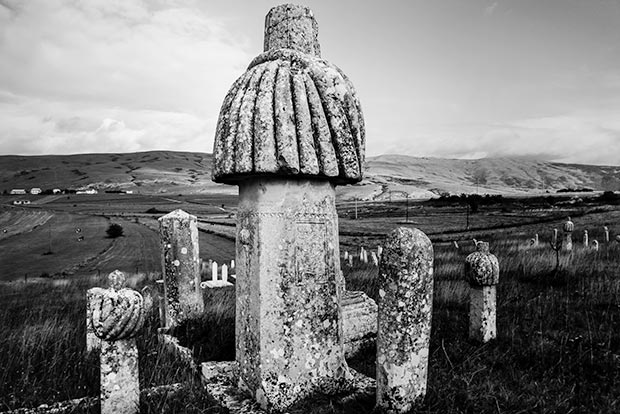
Group Exhibition at the National Museum BiH Memories in Stone: Where We Pray, We Die and Remember
Aug 04, 2018 INSPO, Exhibition

The exhibition was opened by Mirsad Sijarić, Director of National Museum of Bosnia and Herzegovina, and Amila Ramović, Curator of the exhibition. 'Memories in Stone' features works by Bosnian artists who live and work abroad: Amila Buturović, Azra Akhami, Adis Elias Fejzić and Velibor Božović.
-IslamicArtsMagazine_01.jpg) The opening of the group exhibition 'Memories in Stone, Director Mirsad Sijarić (on the right) with the custos Amila Ramović and the artists Azra Akšamija, Velibor Božović, Amila Buturević and Adis Elias Fejzić / Photo © Islamic Arts Magazine
The opening of the group exhibition 'Memories in Stone, Director Mirsad Sijarić (on the right) with the custos Amila Ramović and the artists Azra Akšamija, Velibor Božović, Amila Buturević and Adis Elias Fejzić / Photo © Islamic Arts Magazine
-IslamicArtsMagazine_02.jpg) The opening of the group exhibition 'Memories in Stone / Photo © Islamic Arts Magazine
The opening of the group exhibition 'Memories in Stone / Photo © Islamic Arts Magazine
The tombstones of Bosnia have their monumental continuity, from the Middle Ages to the entire Ottoman period. And in both cases, the Middle Ages tombstones (stećak), and the Islamic tombstones (nišan) have taken on extraordinary stone forms, mainly as a sculpture, remaining an eternal example of the great mastership of the Bosnian stone masons.
-IslamicArtsMagazine_09.jpg) The group exhibition 'Memories in Stone / Photo © Islamic Arts Magazine
The group exhibition 'Memories in Stone / Photo © Islamic Arts Magazine
-IslamicArtsMagazine_10.jpg) The group exhibition 'Memories in Stone / Photo © Islamic Arts Magazine
The group exhibition 'Memories in Stone / Photo © Islamic Arts Magazine
-IslamicArtsMagazine_11.jpg) The group exhibition 'Memories in Stone / Photo © Islamic Arts Magazine
The group exhibition 'Memories in Stone / Photo © Islamic Arts Magazine
The spiritual side of these monuments is also described through this exhibition, as can be seen in the subtitle 'Where We Pray, We Die and Remember', as the starting point of the exhibition is taken by Amila Buturović from her book Carved in Stone, Etched in Memory. Amila Buturović regards old graveyard places of Bosnia as the conquest of Bosnia itself, something that still defines the people of this country, so its research at the same time is ethnological and spiritual, and additional documentary emphasis is given by the black and white photographs of Velibor Božović.
 Velibor Bozovic, Female Muslim tombstone, 1847, Vrbanjuša, Sarajevo. Photo taken at the exhibition by Islamic Arts Magazine
Velibor Bozovic, Female Muslim tombstone, 1847, Vrbanjuša, Sarajevo. Photo taken at the exhibition by Islamic Arts Magazine
 Velibor Bozovic, SteÄak with inscription, Fatnica, BileÄa / Photo taken at the exhibition by Islamic Arts Magazine
Velibor Bozovic, SteÄak with inscription, Fatnica, BileÄa / Photo taken at the exhibition by Islamic Arts Magazine
 Velibor Bozovic, tombstones / Photo taken at the exhibition by Islamic Arts Magazine
Velibor Bozovic, tombstones / Photo taken at the exhibition by Islamic Arts Magazine
 Velibor Bozović, Cemetery Complex, Early Ottoman Muslim Cemetary / Photo taken at the exhibition by Islamic Arts Magazine
Velibor Bozović, Cemetery Complex, Early Ottoman Muslim Cemetary / Photo taken at the exhibition by Islamic Arts Magazine
Azra Akšamija presented the Bosnian kilim 'Monument in Waiting', The Hague, 2008, which was created by women victims after the Bosnian war, under her supervision and instructions. Concept and artistic direction was done by Azra Akšamija, and the conceptual contributions by Mihnea Mircan, Dietmar Offenhuber and Amila Smajović. Bosnian kilim is, along with tombstones, another symbol of cultural and material heritage, and through the exhibition is emphasized as a memory and symbolic marker.
-IslamicArtsMagazine_6.jpg) Visitors in front of the 'Monument in Waiting', The Hague, 2008, Tapestry, wool kilim. Concept and artistic direction: Azra Akšamija. Conceptual contributions: Mihnea Mircan, Dietmar Offenhuber, Amila Smajović / Photo © Islamic Arts Magazine
Visitors in front of the 'Monument in Waiting', The Hague, 2008, Tapestry, wool kilim. Concept and artistic direction: Azra Akšamija. Conceptual contributions: Mihnea Mircan, Dietmar Offenhuber, Amila Smajović / Photo © Islamic Arts Magazine
Finally, Adis Elias Fejzić, one of the most famous Bosnian sculptors, presented a very powerful interpretation of old tombstones form. The tombstones have remained to date a great example of sculptural art, and have also influenced the contemporary sculpture in Bosnia and Herzegovina.
-IslamicArtsMagazine_07.jpg) The group exhibition 'Memories in Stone, sculptures by Adis Elias Fejzić / Photo © Islamic Arts Magazine
The group exhibition 'Memories in Stone, sculptures by Adis Elias Fejzić / Photo © Islamic Arts Magazine
-IslamicArtsMagazine_04.jpg) The group exhibition 'Memories in Stone / Photo © Islamic Arts Magazine
The group exhibition 'Memories in Stone / Photo © Islamic Arts Magazine
-IslamicArtsMagazine_05.jpg) The group exhibition 'Memories in Stone / Photo © Islamic Arts Magazine
The group exhibition 'Memories in Stone / Photo © Islamic Arts Magazine
The exhibition 'Memories in Stone' will be on view until September 30, 2018 at the National Museum of Bosnia and Herzegovina, in Sarajevo.
Comments
Add a comment
Commenting is not available in this section entry.